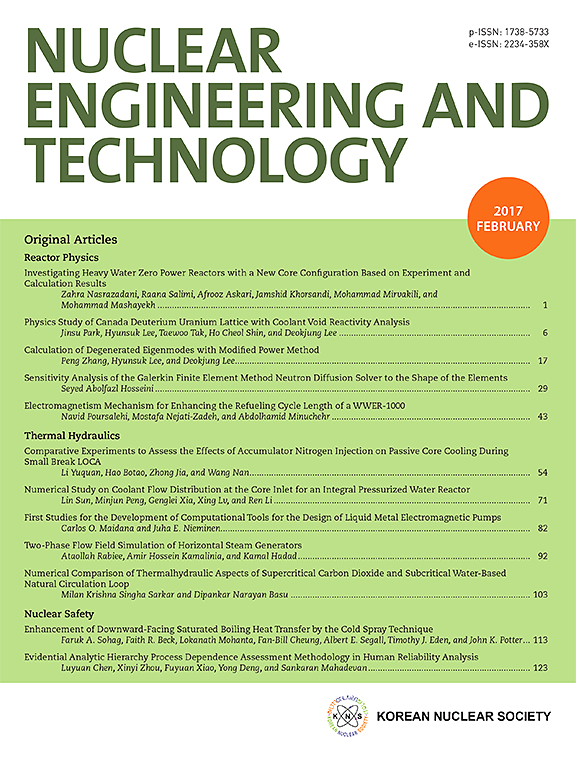Assessment of natural radioactivity and radiological risks in soil from artisanal gold mining sites in West Pokot, Kenya
IF 2.6
3区 工程技术
Q1 NUCLEAR SCIENCE & TECHNOLOGY
引用次数: 0
Abstract
Artisanal gold mining in West Pokot, Kenya, thrives due to rising global demand and accessibility, attracting local and regional stakeholders. Despite its economic significance, miners face radiation exposure from natural radioactive elements, yet awareness of these health risks remains low. This study aims to assess radioactivity in soil in order to understand the radiological risks associated with artisanal gold mining. The activity concentrations in thirty-two soil samples were measured using gamma-ray spectrometry. The results obtained for 226Ra, 232Th, and 40K show average concentrations of 29 ± 6, 30 ± 10, and 516 ± 70 Bq kg−1 respectively. The results of radioecological hazards: radium equivalent, external hazard, absorbed dose rate, annual effective dose equivalent, annual gonadal equivalent dose, and excess lifetime cancer risks were determined to be 110 ± 19 Bq kg−1, 0.30 ± 0.05, 0.38 ± 0.07, 53 ± 12 nGy h−1, 0.06 ± 0.01 mSv y−1, 375 ± 59 μSv y−1, and 0.23 ± 0.05 respectively, all below the threshold limits, except for annual gonadal equivalent dose. The low levels of radionuclides indicate a minimal risk of radiation exposure. These results can help shape artisanal mining regulations by aligning them with national standards, worker education and routine radiation monitoring.
肯尼亚西波科特手工金矿土壤天然放射性和放射性风险评估
由于全球需求和可及性的增加,肯尼亚西波科特的手工金矿蓬勃发展,吸引了当地和区域利益相关者。尽管具有重要的经济意义,但矿工面临着天然放射性元素的辐射暴露,但对这些健康风险的认识仍然很低。本研究旨在评估土壤中的放射性,以了解与手工采金有关的辐射风险。利用伽马射线能谱法测定了32个土壤样品的活性浓度。结果表明,226Ra、232Th和40K的平均浓度分别为29±6、30±10和516±70 Bq kg−1。放射生态学危害结果:镭当量、外源危害、吸收剂量率、年有效剂量当量、年性腺等效剂量和终生过量致癌风险分别为110±19 Bq kg−1、0.30±0.05、0.38±0.07、53±12 nGy h−1、0.06±0.01 mSv y−1、375±59 μSv y−1和0.23±0.05,均低于阈值,但年度性腺等效剂量除外。放射性核素的低水平表明辐射暴露的风险极小。这些结果可以帮助制定手工采矿法规,使其与国家标准、工人教育和常规辐射监测保持一致。
本文章由计算机程序翻译,如有差异,请以英文原文为准。
求助全文
约1分钟内获得全文
求助全文
来源期刊

Nuclear Engineering and Technology
工程技术-核科学技术
CiteScore
4.80
自引率
7.40%
发文量
431
审稿时长
3.5 months
期刊介绍:
Nuclear Engineering and Technology (NET), an international journal of the Korean Nuclear Society (KNS), publishes peer-reviewed papers on original research, ideas and developments in all areas of the field of nuclear science and technology. NET bimonthly publishes original articles, reviews, and technical notes. The journal is listed in the Science Citation Index Expanded (SCIE) of Thomson Reuters.
NET covers all fields for peaceful utilization of nuclear energy and radiation as follows:
1) Reactor Physics
2) Thermal Hydraulics
3) Nuclear Safety
4) Nuclear I&C
5) Nuclear Physics, Fusion, and Laser Technology
6) Nuclear Fuel Cycle and Radioactive Waste Management
7) Nuclear Fuel and Reactor Materials
8) Radiation Application
9) Radiation Protection
10) Nuclear Structural Analysis and Plant Management & Maintenance
11) Nuclear Policy, Economics, and Human Resource Development
 求助内容:
求助内容: 应助结果提醒方式:
应助结果提醒方式:


